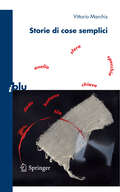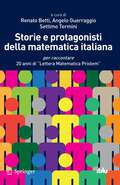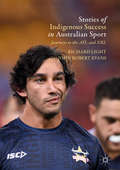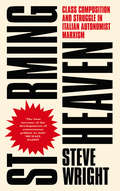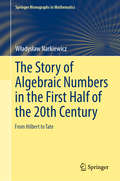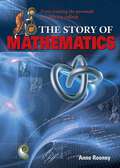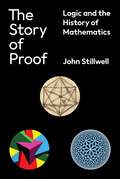- Table View
- List View
Stop Thief!: Anarchism and Philosophy
by Catherine MalabouMany contemporary philosophers – including Michel Foucault, Jacques Derrida, and Giorgio Agamben – ascribe an ethical or political value to anarchy, but none ever called themselves an “anarchist.” It is as if anarchism were unmentionable and had to be concealed, even though its critique of domination and of government is poached by the philosophers. Stop Thief! calls out the plundering of anarchism by philosophy. It’s a call that is all the more resonant today as the planetary demand for an alternative political realm raises a deafening cry. It also alerts us to a new philosophical awakening. Catherine Malabou proposes to answer the cry by re-elaborating a concept of anarchy articulated around a notion of the “non-governable” far beyond an inciting of disobedience or common critiques of capitalism. Anarchism is the only way out, the only pathway that allows us to question the legitimacy of political domination and thereby wfree up the confidence that we need if we are to survive.
Stop Thief!: Anarchism and Philosophy
by Catherine MalabouMany contemporary philosophers – including Michel Foucault, Jacques Derrida, and Giorgio Agamben – ascribe an ethical or political value to anarchy, but none ever called themselves an “anarchist.” It is as if anarchism were unmentionable and had to be concealed, even though its critique of domination and of government is poached by the philosophers. Stop Thief! calls out the plundering of anarchism by philosophy. It’s a call that is all the more resonant today as the planetary demand for an alternative political realm raises a deafening cry. It also alerts us to a new philosophical awakening. Catherine Malabou proposes to answer the cry by re-elaborating a concept of anarchy articulated around a notion of the “non-governable” far beyond an inciting of disobedience or common critiques of capitalism. Anarchism is the only way out, the only pathway that allows us to question the legitimacy of political domination and thereby wfree up the confidence that we need if we are to survive.
Storie di cose semplici (I blu)
by Vittorio MarchisIl dado, il filo, la chiave, l’anello, lo specchio, il bottone e la sfera sono cose semplici che incontriamo quotidianamente, ma di cui spesso ci dimentichiamo, perché la cultura contemporanea sempre più si lascia ammaliare dalla complessità dei sistemi e dalla leggerezza delle realtà virtuali. Questo saggio, facendo il controcanto alle cinque Lezioni americane di Italo Calvino, esamina come le "cose semplici" di fatto spesso dimostrino la loro importanza nella semplicità, nella lentezza, nella pesantezza, nella singolarità, nella stessa invisibilità. Ma la loro "consistenza" – questa appunto avrebbe dovuto essere la sesta Lezione – risiede appunto nel fatto che la loro forza, simbolica e reale sta proprio nel fatto che sono cose concrete, che tutti possiamo toccare, anche quando assumono un significato metaforico. I sette oggetti semplici avrebbero potuto essere accompagnati da molti altri esemplari, ma questo libro deve rimanere soprattutto uno stimolo affinché si possa ricuperare una maggiore attenzione alla concretezza delle cose, che non è solo importante quando sono riposte nelle vetrine di un museo di cultura materiale, ma perché sono parte di noi. Letteratura e tecnica, arte e filosofia, musica e cronaca, ogni giorno dimostrano come queste "cose" siano le vere protagoniste di quella che i francesi chiamano civilization: l’Anello del Nibelungo, il Bottone di Pushkin, e il "dado brunelleschiano" sono soltanto alcuni esempi di come queste "cose" abbiano trovato un posto d’onore nella storia. E questo è un libro in cui si raccontano tante storie, come le fiabe che introducono le nostre cose, per farci entrare nel loro mondo accompagnati dalla fantasia.
Storie e protagonisti della matematica italiana: per raccontare 20 anni di "Lettera Matematica Pristem" (I blu)
by Renato Betti Angelo Guerraggio Settimo Termini20 anni fa – anzi qualcuno in più – iniziava le sue pubblicazioni “Lettera Matematica PRISTEM”, espressione di un gruppo di ricerca della “Bocconi” cui aderiscono anche docenti e studiosi di altre Università. La “Lettera” ha rappresentato un tentativo coraggioso di svecchiare la comunicazione matematica, di renderla meno accademica e più giornalistica con l’uso delle immagini, del colore e di un linguaggio diretto. Un tentativo di inserire la Matematica nei più ampi processi che riguardano la scuola e la società.In questo libro, i tre direttori della rivista sfogliano le sue annate per ricordare storie e personaggi (matematici e non) attorno a cui la “Lettera” è cresciuta e che di fatto hanno contribuito alla formazione della sua linea editoriale.Le testimonianze, i ricordi e i commenti sono seguiti anno per anno da un articolo comparso quell’anno sulla “Lettera”. Ne esce una descrizione del mondo matematico, visto dall’interno, molto più vivace di quanto solitamente si pensa che sia. Altro che semplice calcolo! La Matematica va avanti e la “Lettera” racconta in quali direzioni. Talora procede con appassionate discussioni e qualche polemica che accompagna la ricerca o l’insegnamento o la gestione delle istituzioni scientifiche: anche di queste, in 20 anni, la “Lettera” ha cercato di dare puntualmente conto.
Stories and the Brain: The Neuroscience of Narrative
by Paul B. ArmstrongHow do our brains enable us to tell and follow stories? And how do stories affect our minds? In Stories and the Brain, Paul B. Armstrong analyzes the cognitive processes involved in constructing and exchanging stories, exploring their role in the neurobiology of mental functioning. Armstrong argues that the ways in which stories order events in time, imitate actions, and relate our experiences to others' lives are correlated to cortical processes of temporal binding, the circuit between action and perception, and the mirroring operations underlying embodied intersubjectivity. He reveals how recent neuroscientific findings about how the brain works—how it assembles neuronal syntheses without a central controller—illuminate cognitive processes involving time, action, and self-other relations that are central to narrative.An extension of his previous book, How Literature Plays with the Brain, this new study applies Armstrong's analysis of the cognitive value of aesthetic harmony and dissonance to narrative. Armstrong explains how narratives help the brain negotiate the neverending conflict between its need for pattern, synthesis, and constancy and its need for flexibility, adaptability, and openness to change. The neuroscience of these interactions is part of the reason stories give shape to our lives even as our lives give rise to stories.Taking up the age-old question of what our ability to tell stories reveals about language and the mind, this truly interdisciplinary project should be of interest to humanists and cognitive scientists alike.
Stories Matter: The Role of Narrative in Medical Ethics (Reflective Bioethics)
by Rita Charon Martha MontelloFirst published in 2002. Routledge is an imprint of Taylor & Francis, an informa company.
Stories Matter: The Role of Narrative in Medical Ethics (Reflective Bioethics)
by Rita Charon Martha MontelloFirst published in 2002. Routledge is an imprint of Taylor & Francis, an informa company.
Stories of Indigenous Success in Australian Sport: Journeys to the AFL and NRL
by Richard Light John Robert EvansThis book presents journeys of sixteen Indigenous Australian athletes from their first touch of a‘footy’ to the highest levels of Australian football and rugby league, conceptualized as a processof learning. The authors challenge simplistic explanations of Indigenous success in Australianfootball and rugby league, centered on the notion of the ‘natural athlete’. The book tracesthe development of Indigenous sporting expertise as a lifelong process of learning situated inlocal culture and shaped by the challenges of transitioning into professional sport. Individually,the life stories told by the participants provide fascinating insights into experience, cultureand learning. Collectively, they provide deep understanding of the powerful influence thatAboriginal culture exerted on the participants’ journeys to the top of their sports while locatingindividual experience and agency within larger economic, cultural and social considerations.Stories of Indigenous Success in Australian Sport will be of interest to students and scholarsacross a range of disciplines including Indigenous studies, physical education, education, sportmanagement and sociology
Stories of the Buddha: Being Selections from the Jataka
by Caroline A. DavidsOne of the most important texts in the literature of Buddhism, the Jātaka contains stories that celebrate the previous lives of the Buddha. The future Buddha may appear in these "jātakas" as a king, an outcast, a god, an elephant — but in whatever form he takes, he exhibits some virtue which the tale then proceeds to inculcate in the reader.This superb selection of 47 stories of the Buddha — among them "The Bar of Gold Jātaka," "The King's Lesson Jātaka," "The Gem-Thief Jātaka," and "The Great Ape Jātaka" — are filled with humor, pathos, and narrative appeal that have endeared them to generations of Buddhists and to audiences around the world. Many are directly related to ancient Indian folklore and top the traditional stories and myths of other cultures, among them the beast fables of Aesop. Many have been the subject of countless works of Buddhist art.Although the settings of the stories are often imaginary, they offer scholars, students, and enthusiasts of Buddhism and Buddhist culture and society. This collection has been edited and translated by one of the most distinguished Western scholars of Buddhism, Caroline A. F. Rhys Davids, who has contributed a lively introductory essay to these landmarks of folk literature.
Storm in a Teacup: The Physics of Everyday Life
by Helen CzerskiJust as Freakonomics brought economics to life, so Storm in a Teacup brings physics into our daily lives and makes it fascinating. Our world is full of patterns. If you pour milk into your tea and give it a stir, you’ll see a swirl, a spiral of two fluids, before the two liquids mix completely. The same pattern is found elsewhere too. Look down on the Earth from space, and you’ll find similar swirls in the clouds, made where warm air and cold air waltz. In Storm in a Teacup, Helen Czerski links the little things we see every day with the big world we live in. Each chapter begins with something small – popcorn, coffee stains and refrigerator magnets – and uses it to explain some of the most important science and technology of our time. This is physics as the toolbox of science - a toolbox we need in order to make sense of what is around us and arrive at decisions about the future, from medical advances to solving our future energy needs. It is also physics as the toy box of science: physics as fun, as never before.
Storming Heaven: Class Composition and Struggle in Italian Autonomist Marxism
by Steve Wright'The emergence of a new wave of anti-capitalist activism on the streets of Seattle, Prague and Genoa has been accompanied by a growing interest in "autonomist Marxism." Steve Wright’s study brilliantly illuminates the history, complexity and internal debates of this tradition ... A vital, lucid contribution to understanding how the red threads of Marxism are being rewoven into the fabric of twenty-first century radicalism.' Nick Dyer-Witheford, author of Cyber-Marx Storming Heaven is the first comprehensive survey of Italian autonomist theory, from its origins in the anti-stalinist and workerist left of the 1950s to its heyday twenty years later. Autonomist marxism was a political tendency which privileged themes--self-organisation, construction of identity, grassroots politics, subjects in struggle--which in many ways can be seen as the precursor of today's debates around direct action protest. Emphasising the dynamic nature of class struggle as the distinguishing feature of autonomist thought, Wright explores how its understanding of class politics developed alongside emerging social movements. Offering a critical and historical exploration of the tendency's emergence in postwar Italy, Storming Heaven moves beyond the crisis of traditional analytical frameworks on the left, and assesses the strengths and limitations of autonomist marxism as first developed by Antonio Negri, Mario Tronti, Sergio Bologna and others.
Storming Heaven: Class Composition and Struggle in Italian Autonomist Marxism
by Steve Wright'The emergence of a new wave of anti-capitalist activism on the streets of Seattle, Prague and Genoa has been accompanied by a growing interest in "autonomist Marxism." Steve Wright’s study brilliantly illuminates the history, complexity and internal debates of this tradition ... A vital, lucid contribution to understanding how the red threads of Marxism are being rewoven into the fabric of twenty-first century radicalism.' Nick Dyer-Witheford, author of Cyber-Marx Storming Heaven is the first comprehensive survey of Italian autonomist theory, from its origins in the anti-stalinist and workerist left of the 1950s to its heyday twenty years later. Autonomist marxism was a political tendency which privileged themes--self-organisation, construction of identity, grassroots politics, subjects in struggle--which in many ways can be seen as the precursor of today's debates around direct action protest. Emphasising the dynamic nature of class struggle as the distinguishing feature of autonomist thought, Wright explores how its understanding of class politics developed alongside emerging social movements. Offering a critical and historical exploration of the tendency's emergence in postwar Italy, Storming Heaven moves beyond the crisis of traditional analytical frameworks on the left, and assesses the strengths and limitations of autonomist marxism as first developed by Antonio Negri, Mario Tronti, Sergio Bologna and others.
Storming Heaven - Second Edition: Class Composition and Struggle in Italian Autonomist Marxism
by Steve WrightStorming Heaven is the only book which looks at Italian workerist theory and practice, from its origins in the anti-Stalinist left of the 1950s to its heyday twenty years later. It focuses on the theme of workerism, or 'operaismo', which includes the refusal of work, class self-organisation, mass illegality and the extension of revolutionary agency, of of which are still practiced today by workers across the world.*BR**BR*Emphasising the dynamic nature of class struggle as the distinguishing feature of workerist thought, Storming Heaven reveals how this form of radical politics developed alongside emerging social movements to great effect. It assesses the strengths and limitations of workerism as first developed by Antonio Negri, Mario Tronti, Sergio Bologna and others.*BR**BR*This edition includes a new chapter looking at the debates around operaismo and Autonomia since the book originally appeared in 2002, and is updated with a new foreword and afterword.
Storming Heaven - Second Edition: Class Composition and Struggle in Italian Autonomist Marxism
by Steve WrightStorming Heaven is the only book which looks at Italian workerist theory and practice, from its origins in the anti-Stalinist left of the 1950s to its heyday twenty years later. It focuses on the theme of workerism, or 'operaismo', which includes the refusal of work, class self-organisation, mass illegality and the extension of revolutionary agency, of of which are still practiced today by workers across the world.*BR**BR*Emphasising the dynamic nature of class struggle as the distinguishing feature of workerist thought, Storming Heaven reveals how this form of radical politics developed alongside emerging social movements to great effect. It assesses the strengths and limitations of workerism as first developed by Antonio Negri, Mario Tronti, Sergio Bologna and others.*BR**BR*This edition includes a new chapter looking at the debates around operaismo and Autonomia since the book originally appeared in 2002, and is updated with a new foreword and afterword.
Stormy Weather: The New Hampshire Primary and Presidential Politics
by D. ScalaIn the coming presidential primaries, no state is as important in setting the stage - or affecting the odds - as New Hampshire. This small, mountainous, proudly distinctive state holds the first primary and the results, both real and in comparison to expectations, can greatly influence the competition for the highest office in the land. Candidates who do well can create momentum and gain support, while those who do worse than expected can be counted out. Scala explains the distinctiveness of New Hampshire politics and how the candidates create strategies to appeal to the state's voters. New Hampshire's sympathy for reformist candidates has the paradoxical affect of jumpstarting the campaigns of those candidates least representative of Democratic voters nationally. The implications for Democratic chances to win the presidency in 2004 are discussed.
Story and Philosophy for Social Change in Medieval and Postmodern Writing: Reading for Change
by Allyson CarrThis book bridges medieval and contemporary philosophical thinkers, examining the relationship between fiction and philosophy for bringing about social change. Drawing on the philosophical reading and writing practices of medieval author Christine de Pizan and twentieth-century philosopher Luce Irigaray, and through an engagement with Hans-Georg Gadamer’s work on tradition and hermeneutics, it develops means to re-write the stories and ideas that shape society. It argues that reading for change is possible; by increasing our capacity to perceive and engage tradition, we become more capable of positively shaping the forces that shape us. Following the example of the two women whose work it explores, Story and Philosophy works through philosophy and narrative to deeply transform the allegorical, political, and continental tradition it engages. It is essential reading for students and scholars interested in medieval studies, feminist studies, and critical theory.
Story and Philosophy for Social Change in Medieval and Postmodern Writing: Reading for Change
by Allyson CarrThis book bridges medieval and contemporary philosophical thinkers, examining the relationship between fiction and philosophy for bringing about social change. Drawing on the philosophical reading and writing practices of medieval author Christine de Pizan and twentieth-century philosopher Luce Irigaray, and through an engagement with Hans-Georg Gadamer’s work on tradition and hermeneutics, it develops means to re-write the stories and ideas that shape society. It argues that reading for change is possible; by increasing our capacity to perceive and engage tradition, we become more capable of positively shaping the forces that shape us. Following the example of the two women whose work it explores, Story and Philosophy works through philosophy and narrative to deeply transform the allegorical, political, and continental tradition it engages. It is essential reading for students and scholars interested in medieval studies, feminist studies, and critical theory.
Story of a Death Foretold: The Coup Against Salvador Allende, September 11, 1973
by Oscar Guardiola-RiveraOn the fortieth anniversary of revolution and rebellion in Chile, a searching history of the rise and fall of the world's first and only democratically elected Marxist president. On September 11, 1973, President Salvador Allende of Chile was deposed in a violent coup led by General Augusto Pinochet. The coup had been in the works for months, even years. Shortly after giving a farewell speech to his people, Allende died of gunshot wounds-whether inflicted by his own hand or an assassin's remains uncertain. Pinochet ruled Chile for a quarter century, but the short rise and bloody fall of Allende is still the subject of fierce historical debate.In a world in the throes of the Cold War, the seeming backwater of Chile became the host of a very hot conflict-with Henry Kissinger and the Western establishment aligned with Pinochet's insurgents against a socialist coalition of students, workers, Pablo Neruda, and folk singers, led by the brilliant ideologue Allende. Revolution and counterrevolution played out in graphic detail, moving the small South American nation to the center of the world stage in the dramatic autumn of 1973. Now the rising young scholar Oscar Guardiola-Rivera gives us a tour de force account of a historical crossroads, tracing the destiny of democracy, and the paths of power, money, and violence that still shadow Latin America and its relations with the United States.
The Story of Algebraic Numbers in the First Half of the 20th Century: From Hilbert to Tate (Springer Monographs in Mathematics)
by Władysław NarkiewiczThe book is aimed at people working in number theory or at least interested in this part of mathematics. It presents the development of the theory of algebraic numbers up to the year 1950 and contains a rather complete bibliography of that period. The reader will get information about results obtained before 1950. It is hoped that this may be helpful in preventing rediscoveries of old results, and might also inspire the reader to look at the work done earlier, which may hide some ideas which could be applied in contemporary research.
The Story of International Relations, Part One: Cold-Blooded Idealists (Palgrave Studies in International Relations)
by Jo-Anne PembertonThis book is the first volume in a trilogy that traces the development of the academic subject of International Relations, or what was often referred to in the interwar years as International Studies. This first volume takes on the origins of International Relations, beginning with the League of Nations and the International Studies Conference in Berlin in 1928 and tracing its development through the Paris Peace Conference, the quest for cooperation in the Pacific, the Institute of Pacific Relations and lessons from Copenhagen, Shanghai and Manchuria. This project is an impressive and exhaustive consideration of the evolution of IR and is aptly published in celebration of the discipline's centenary.
The Story of International Relations, Part Three: Cold-Blooded Idealists (Palgrave Studies in International Relations)
by Jo-Anne PembertonThis book is the third volume in a trilogy that traces the development of the academic subject of International Relations, or what was often referred to in the interwar years as International Studies. This volume explores how International Relations progressed through the 20th century looking specifically at World War II, from the looming world war to the post-War reconstruction in Europe. This one of a kind project takes on the task of reviewing the development of IR, aptly published in celebration of the discipline’s centenary.
The Story of International Relations, Part Two: Cold-Blooded Idealists (Palgrave Studies in International Relations)
by Jo-Anne PembertonThis book is the second volume in a trilogy that traces the development of the academic subject of International Relations, or what was often referred to in the interwar years as International Studies. In this volume, the author begins with the 1932 Mission to China and conference in Milan, examines the International Studies Conference, reviews the Hoover Plan, the MacDonald Plan, the fate of the World Disarmament Conference, and the League of Nations’ role in the discipline. This one of a kind project takes on the task of reviewing the development of IR, aptly published in celebration of the discipline’s centenary.
The Story of Mathematics: From creating the pyramids to exploring infinity (The Story of)
by Anne Rooney'In order to understand the universe you must know the language in which it is written. And that language is mathematics.' - Galileo (1564-1642) For hundreds of thousands of years, we have sought order in the apparent chaos of the universe. Mathematics has been our most valuable tool in that search, uncovering the patterns and rules that govern our world and beyond. How the World Works: Mathematics serves as a brilliant introduction to the history and enigmas of this vast discipline, plotting a journey from innumerate cave-dwellers, through the towering mathematical intellects of the last 4,000 years, to the breakthroughs of today. Topics include: • Counting and measuring from the earliest times• The Ancient Egyptians and geometry • Working out the movement of the planets • Algebra, solid geometry and the trigonometric tables • The first computers How statistics came to rule our finances • Impossible shapes and extra dimensions • Measuring and mapping the world • Chaos theory and fuzzy logic • Set theory and the death of numbers The fascinating personalities behind world-changing discoveries in mathematics are profiled, including Euclid, Apollonius, Pythagoras, Brahmagupta, Aryabhata, Liu Hui, Omar Khayyam, al-Khwarizmi, Napier, Galileo, Pascal, Newton, Leibniz, Gauss, Riemann, Russell and many more.
The Story of Philosophy: A History of Western Thought
by Jeremy Stangroom James GarveyThe Story of Philosophy sees philosophy for what it is: a passionate, exhilarating quest for human understanding that cannot be reduced to dry categories or simple definitions. It's a story with plot twists, a murder, accidental discoveries, disastrous love affairs, geniuses, idiots, monks, and vagabonds. At the heart of it all are the ideas and obsessions that have captured great thinkers from the very beginning. Packed with intriguing anecdotes and fascinating detail, James Garvey and Jeremy Stangroom bring us face to face with the most important philosophers in western history. Rigorous, refreshingly free of academic jargon, and highly accessible, this is the ideal introduction for anyone who wants to gain a new perspective on philosophy's biggest thoughts.
The Story of Proof: Logic and the History of Mathematics
by John StillwellHow the concept of proof has enabled the creation of mathematical knowledgeThe Story of Proof investigates the evolution of the concept of proof—one of the most significant and defining features of mathematical thought—through critical episodes in its history. From the Pythagorean theorem to modern times, and across all major mathematical disciplines, John Stillwell demonstrates that proof is a mathematically vital concept, inspiring innovation and playing a critical role in generating knowledge.Stillwell begins with Euclid and his influence on the development of geometry and its methods of proof, followed by algebra, which began as a self-contained discipline but later came to rival geometry in its mathematical impact. In particular, the infinite processes of calculus were at first viewed as “infinitesimal algebra,” and calculus became an arena for algebraic, computational proofs rather than axiomatic proofs in the style of Euclid. Stillwell proceeds to the areas of number theory, non-Euclidean geometry, topology, and logic, and peers into the deep chasm between natural number arithmetic and the real numbers. In its depths, Cantor, Gödel, Turing, and others found that the concept of proof is ultimately part of arithmetic. This startling fact imposes fundamental limits on what theorems can be proved and what problems can be solved.Shedding light on the workings of mathematics at its most fundamental levels, The Story of Proof offers a compelling new perspective on the field’s power and progress.

